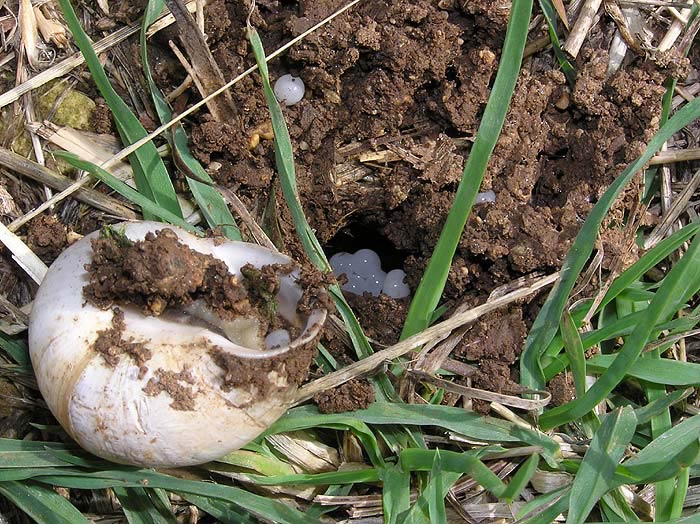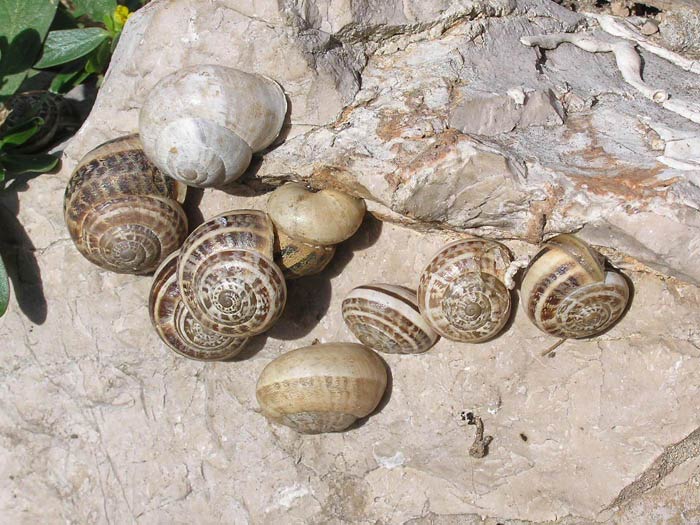Eobania vermiculata
|
Eobania vermiculata. (Photo: © J. Novak, www.biolib.cz) |
|
Eobania vermiculata: adult with eggs. (Photo: © J. Novak, www.biolib.cz) |
|
Eobania vermiculata: note pattern variation. (Photo: © J. Novak, www.biolib.cz) |
|
Eobania vermiculata. (Photo: © T. Grasso, Wikipedia) |
|
Eobania vermiculata. (Photo: © A. Butko, Wikipedia) |
|
Eobania vermiculata. (Photo: © Ranko, Wikipedia) |
|
Eobania vermiculata. (Photo: © T. Schoch, Wikipedia) |
Family
Helicidae
Species
Eobania vermiculata (Muller, 1774)
Common name
Chocolate-band snail
Description
This snail's shellShell:
A hard, inflexible, calcareous or chitinous structure that vary in size and may either completely encasing the animal, covering some part of it or be internal.
is whitish (with yellow to grey-brown tinge) in color with four or five chestnut-brown to chocolate stripes that are more or less spotted or speckled with white. Albino variants do exist (i.e. they do not have stripes). The peristomePeristome:
Margin of the aperture of a snail's shell. This region may be thickened in mature animals.
is also white. The thick-walled shellShell:
A hard, inflexible, calcareous or chitinous structure that vary in size and may either completely encasing the animal, covering some part of it or be internal.
of this species has 5-6 whorlsWhorls:
Pleural of whorl. A whorl is a complete spiral turn/growth of the shell of a mollusc. The whorls are counted from the apex outwards.
and may attain a heightHeight:
The height of the shell is a measure of the distance between the apex and the most basal part of the shell OR the measurement taken from the apex of the shell to the base, when measured parallel to the axis of the shell.
of 14-27 mm and a diameter of 22-30 mm although specimens have been reported to measure 35 mm. The umbilicusUmbilicus:
A navel-like indentation or depression in the center of the shell. It may be described as open (inside of columella visible), partially closed (partly covered by base of aperture) or completely closed (not visible). The width of the umbilicus is a measure of its greatest diameter.
(navel) is inconspicuous.
Native range
Mediterranean region
Distribution
North America:
- U.S.
Other: Mediterranean region
Ecology
This species inhabits fields, gardens and vineyards. During the day, the animal aestivates on vertical structures (e.g., trees, palms, bushes, fences).
Synonyms
- Helix vermiculata Muller, 1774
References
Cowie et al. 2009; Pilsbry 1939Pilsbry 1939:
Pilsbry, H. A. 1939. Land Mollusca of North America north of Mexico vol. I part 1. Academy of Natural Sciences, Philadelphia. pp. 1-574.; Kerney et al. 1979Kerney et al. 1979:
Kerney, M.P., R.A.D. Cameron and G. Riley. 1979. A field guide to the land snails of Britain and North-west Europe. Collins, London. pp. 288.; Yildirim et al. 2004Yildirim et al. 2004:
Yildirim, M.Z., U. Kebapçl and B.A. Gümüs. 2004. Edible snails (Terrestrial) of Turkey. Turkish Journal of Zoology 28: 329-335.




